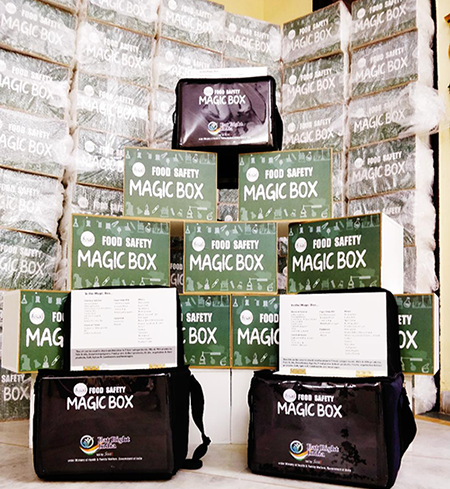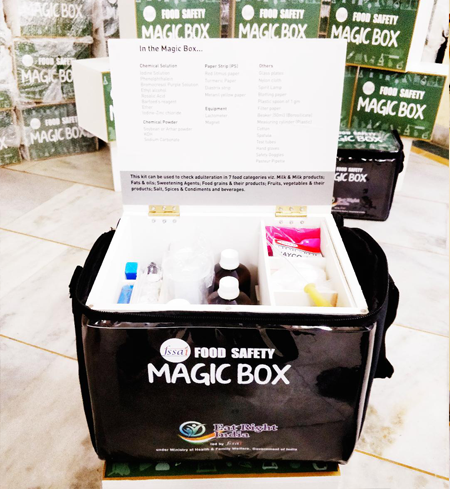- Welcome to Starting Business company
Food Testing Kit
Food Safety Magic Box
Food Safety Magic Box
Model no - SISCO-FSMB102T
- 100 Tests for in 07 Food Categories.
- Contains basic chemicals & small instruments (Lactometer & Magnet).
- Acid/Alkali Solution required in some tests.
- Minimal cost involved.
Introduction
Food travels through multiple stages such as production processing, distribution, retail shops or restaurants to reach your
plate. During this journey, the food may become unsafe because of various factors. The most commonly
used terms in case of unsafe foods are contamination and adulteration.

Contamination and adulteration both may involve the presence of a substance that is not tended to be in the food. The difference
is that contamination is unintentional. It may result from natural causes (e.g., heavy metals
of the soil that are taken up plants) or as consequences of improper quality control in the factory
producing food (e.g. introduction of hair or glass pieces during manufacturing).
Adulteration, on the other hand, is generally economically motivated. It often involves intentional replacement of superior
quality ingredient, or its dilution, with a cheaper alternative. For e.g., dilution of milk with
water increase its volume. Not every case of adulteration will result in serious adverse health
effects. However, adulteration always results in the introduction of unknown hazards and hence
unknown risks into the food product.
Food spoilage occurs when there's a disagreeable change in the normal state of the food. This may be a change to the smell,
taste, touch or sight of the food. Spoilage is usually caused by bacteria, moulds or yeasts;
A typical example of spoilage is green fuzzy patches appearing on a piece of bread.
Food contamination, adulteration and spoilage put a lot of people at risk but it can be detected by different ways. One of
the simplest ways to detect whether something is wrong with your food is through senses of sight,
smell, touch and hearing. For example, signs of spoilage on fruits and vegetables are fuzzy and
colored mould growth, a soft and mushy consistency and a bad smell. Other signs of Spoilage such
as in canned foods include a bulging can or lid, a strong smell when you open the can, gas or
squirting liquids, or cloudy mushy food. Similarly, some of the common adulterants in food can
also be detected through sensory examination. For example, addition of papaya seeds to black
pepper can be detected visually,
However not all unsafe and/or adulterated foods may demonstrate bad quality, that is, unsafe food may appear to be of good
quality. This distinction between safe and unsafe food therefore requires basic, intermediate
and advanced level of analysis.
Basic analysis can be performed at home or in a school laboratory setting with the use of very few equipment, chemicals and
lab ware. Example of basic analysis would include detection of adulteration with water in milk,
adulteration with prohibited colors in jaggery and sugar, adulteration with mineral acid in beverages
etc. Basic analytical tests are often used to indicate 'absence' or 'presence' of the negative
attributes in a food. Such tests are often referred to as 'Qualitative' and tell us 'WHAT is
there in a food sample
However, at times, it is also important to go a step further and quantify certain attributes in a food. Some basic tests
allow measurements to be made in a range' thereby giving 'semi-quantitative information. For
example, rapid colorimetric test kits used to detect adulteration of mustard oil with butter
yellow (adulterant). A drop of oil sample is placed on a colour detection strip. If adulterated
with Butter Yellow, the colour of the strip changes to pink. Minimum detection limit of his test
is 0.001 % or 10 ppm (parts per million). The color produced by the oil sample can be by compared
with standard colour bands printed on the cover sheet to identify the 'range of concentration
of the adulterant.
Intermediate tests; require slightly advanced level of instrumentation and skills. Such tests are often referred to as Quantitative
and tell us 'HOW MUCH' is there in a food sample with a slightly higher degree of precision.
These tests can be performed by semi-skilled technicians. For example, the Mobile Food Testing
Laboratory, also known as 'Food Safety on Wheels' is a unique mobile lab that can perform 23
tests to check for adulteration in milk and milk products. It also has the facility of a rapid
milk screening apparatus named Milkoscreen which can provide the values of Fat, Solids-Not-Fat,
Protein and can also detect 5 common adulterants.
Sometimes it is difficult to detect very low levels of negative and positive attributes in a food or a much higher degree
of precision is required than offered by intermediate analysis. Additionally, you may want very
specific or targeted information about a food for example the botanical or geographical origin
of honey. For all such requirements, Advanced analysis is needed which is conducted in specialized
laboratories by highly skilled technicians using state-of-the-art modern equipment
For example, inductively coupled plasma mass spectrometry (ICP-MS) is often used if to detect heavy metals contaminants like
lead, copper, cadmium, arsenic etc. in food. This is an elemental analysis technology capable
of detecting most of the periodic table elements at milligram to nanogram levels in a food sample.
Similarly, HPLC (High Performance Liquid Chromatography) is used in the analysis of low to non-volatile
organic compounds like certain Vitamins. it involves separation of the various constituents in
a food sample followed by their individual detection and quantification. A liquid carrier stream
termed as the mobile phase (solvent) serves to carry the injected sample through the separation
column and to the detector. In the separation column the individual components are separated
on the basis of physicochemical interactions and the elution order is based on such interactions.
The separated components are detected by the detector on the basis of absorption of light or
changes in refractive index,electrochemical/conductivity changes or simply the size distribution
of eluting molecules. Another advanced technique called Gas Chromatography/Mass Spectrometry
(GC/MS) separate chemical mixtures (the GC component) and identifies the components at a molecular
level (the MS component).The heated gases of the sample are carried through a column with an
inert gas (such as helium). As the separated substances emerge from the column opening, they
flow into the MS. Mass spectrometry ionizes atoms or molecules to facilitate their separation
and detection in accordance with their molecular masses and charges (mass to charge ratio). LC/MS
(Liquid Chromatography - Mass Spectrometry) combines the separating power of HPLC with the detection
power of Mass spectrometry. The difference between traditional LC and HPLC is that the solvent
in LC travels by the force of gravity. In HPLC, the solvent travels under high pressure obtained
by means of a pump to overcome the pressure drop in the packed column, which reduces the time
of separation.
Based on the hierarchy of different types of analysis described above, Food Safety Magic Box sits within the Basic' level.
It is expected to inculcate a sense of curiosity amongst students and empower them to differentiate
between safe and unsafe food.
Food Adulteration
Food adulteration refers to the process by which the quality or nature of a given food is altered through either the addition
of adulterants and/or through removal of a vital substance from the food. Food adulterants
refer to the foreign, usually inferior substances added to the food which may cause harm
to the consumer or introduce unknown hazards in the food. Basically, during food adulteration,
small quantities of non-nutritious substances are added intentionally to improve the appearance,
texture or storage properties of the food.
The main type of adulteration is Economically Motivated Adulteration (EMA) which is targeted towards financial advantages.
This is also known as 'Food Fraud'. The various forms of adulteration or food fraud with
a potential ta hamper food quality and safety could include the following
- Dilution of food
- Substitution (whole or in part) of food with inferior or cheaper quality substances/ingredients
- Addition of unapproved or illegal ingredients/substances
- Over use in excess of legally prescribed limits) of certain ingredients, additives etc to improve appearance, texture or shelf life of foods
- Mislabelling of food with an intent to mislead consumers
- Tampering
- Counterfeiting etc.

Types of Food Adulteration
- Intentional adulteration: The adulterants are added as a deliberate act with intention to increase profit.In. Sand, marble chips, stones, chalk powder, etc.
- Incidental/ Unintentional Adulteration: Adulterants are found in food due to negligence, ignorance or lack of proper facilities. E.g., pesticide residues as a result of poor agricultural practices, insect larvae or bird droppings due to poor hygienic practices at processing level.
How to check if food is adulterated?
Various booklets and manuals have been provided by FSSAI related to food testing. Some of the booklets/ manuals are helpful
to provide information regarding checking and testing of adulteration.
- DART: Detect Adulteration with Rapid Test (DART) booklet is a compilation of common tests for detection of food adulteration at household level. These tests are simple, quick and can be performed without any chemicals. The primary objective of this initiative is to create food safety awareness amongst consumers.
- Food Safety Magic Box Companion guidebook: This book contains more than 100 tests to support students in their food safety learning journey. The tests can be performed with or without chemicals and are helpful to detect common food adulterants.
- Manual of simple methods for testing common adulterants In food (Food Safety on Wheels: This manual is available on Mobile Food Testing Laboratories or Food Safety on Wheels. Food Safety on Wheels can be used to form more than 100 tests to detect common food adulterants. The tests are over and above what has been provided in DART and Food Safety Magic Box Companion Book.
The companion book of Food safety magic box is your innovative classroom link between food science and health. So let's get
started.
This Food Safety Magic Box provides you with some basic tests of sensory evaluation and adulteration for seven categories of foods namely,
- Sensory Evalution
- Milk and Milk Products
- Fats, Oils and Fat Emulsions
- Sweetening Agents
- Food Grains and their products
- Fruits, Vegetables and their products
- Salt, Spices and Condiments
- Beverages
Food Safety Magic Box
- 100 Tests for in 07 Food Categories.
- Contains basic chemicals & small instruments (Lactometer & Magnet).
- Acid/Alkali Solution required in some tests.
- Minimal cost involved.
